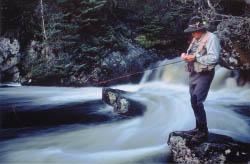Saskatchewan's Inland Sea
Lake Diefenbaker, Part 2

By Chris Marshall from conversations
with Bob Sheedy
Bob Sheedy Photos
Coulee Hopping
Most of the shoreline of Lake Diefenbaker is private farmland with
only limited public access, which means that most of the coulees are
hard to reach by land. Permission can be obtained from some landowners,
but the simplest means of access is by boat. This is what local fly fishers
call 'coulee hopping'.

A boat of at least 20' is desirable, as the wind frequently funnels down
the lake, raising a vicious chop, which make it dangerous for anything
smaller. While it's possible to fish from the boat, it's much more effective
to use the boat merely as a means of getting from one coulee to the next
and to fish either from shore or a float tube. This is because the rainbows,
particularly, are easily spooked in the clear water. Trout are much less
sensitive to anglers wading the shoreline or paddling a float tube within
casting distance of the weeds and other structures along the shore. However,
as places where it is shallow enough to wade are few, a float tube is virtually
indispensible.
Techniques for rainbows and goldeye are very similar. The only significant
differences are that goldeye are much less easily spooked than trout, and
that they travel in much more coherent schools - if you get one goldeye,
you're sure get a bunch more in the same place.
|
A 6wt outfit with both sinking and floating weight-forward lines is ideal
in normal conditions, but a step up to a 7wt or even 8wt is necessary
to punch out the line in windy conditions. Fine tippets are often needed,
especially when the rainbows are finicky, but should be heavy enough
to hold big, strong fish among weeds and other structure. The reel
should have enough capacity to hold plenty of backing, as 20' plus
rainbows can take off on blistering runs.
|
When either species is feeding on baitfish, you'll frequently see the latter
scattering or the swirls of the former as they pursue them. The usual technique
is to cast beyond the disturbance and strip a minnow or leech imitation just
beneath the surface, or twitch a more bulky pattern such as a marabou muddler
in a series of skitters and dives on the surface. Leech patterns and woolly
buggers are often used when the fish are right in the weeds.
|
Neither the rainbows nor goldeye are particularly selective. There's
considerable room for experiment here both with pattern and colour.
- DRIES
Tom Thumb
Hair Wing Caddis
Wulffs
- NYMPHS & EMERGERS
Scuds
Damselflies
Chironomids
- STREAMERS, BUCKTAILS & LURES
Muddler
Marabou Muddler
Zonker
Woolly Bugger
Leeches
Minnow patterns, especially emerald shiner.
|
The best dry fly action usually occurs from just before sunset until darkness,
when the surface comes alive with both rainbows and goldeye gulping in caddis
and chironomids. Hairwing caddis patterns fished with the occasional twitch
can provoke explosive takes. There are hatches from June and throughout the
summer, with one of the most spectacular, the Big Brown Sedge, coming off
in September.
As the water cools after September, hatches decline, but action is still possible
by using subsurface invertebrate patterns such as scuds and damselfly larvae.
However, the best action is with baitfish imitations for rainbows foraging in
pockets of water close to sun-warmed structure. This action can last right into
November.
|
There are motels in a number of small towns close to the lake. These
include: Elbow, Hanely, Guernsey, Lanigan, Outlook, Vanscoy, and
St. Louis. The most convenient is Elbow, which besides its on-shore
location and launch/marina facilities, is close to two provincial parks
with shoreline access. |
On occasions when it's too windy to use a boat, there are a few places
where there is easy overland public access to coulees. These include the
three provincial parks, four regional parks, and marinas such as the Lake
Diefenbaker Yacht Club at Elbow.
The Future
Lake Diefenbaker is still in the process of being explored by fly fishers.
At this point they are a tiny minority compared with the number of other
anglers who troll for walleye and pike. The prospect of discovering the
huge potential for fly fishing is incredibly exciting, particularly since the
recent experimental stocking of Atlantic salmon. And although it is
considerably smaller than the Great Lakes, Lake Diefenbaker is big
enough to have a similar potential as a first class fishery - not to mention
superior opportunity for fly fishers. After listening enviously to Bob
describe his and his friends' exploits there, I'm determined to return to
that valley I last saw almost 40 years ago, to experience its transformation
first hand. Next June sounds like a good time. ~ Chris Marshall
|





